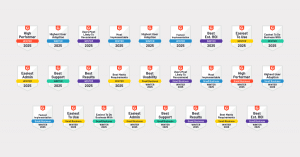Synergy product manager Paul Hemmings says, “one of the new opportunities that’s come with moving to the cloud is that it’s much easier now to integrate one software with another”. APIs (application programming interfaces) provide this mode of integration. Paul knows what he’s talking about, but why on earth should we care? Good question. Glad you asked. Here’s the downlow on what the hell APIs are, and why they’re important to your AEC design business.
APIs — what they are and why you care
APIs are a set of rules that allow one computer or software to talk to another. That’s the simplified version, but it’s really all you need to know — and essentially, it’s all that us non-programmer-types can grasp, so, you know…
According to technology media site Propmodo, they can act as a translator between two systems that don’t otherwise know how to communicate.“ These amazing protocols can push and pull a massive amount of data and have enabled the modern tech stack.”
Right, so, we know what they do. But why do we architecture, engineering and construction design business bods care? Well, we care because these days, digitization is a fact of modern business — we have apps to run our accounting, our project management, our internal and external communications activities, our invoicing systems, our diaries, and pretty much everything else we rely on, up to and including our recreational enjoyment of Candy Crush.
So, software solutions provide more and more of the backbone of our business operations — a fact that is only set to proportionately increase ad infinitum — and therefore the ways these programs interact is going to determine the flow (or lack thereof) of our workflows. Hashtag fact.
Use and connect apps you and your team already work with
In its article The digital workforce experience, Deloitte says that the average number of systems workers must access as part of their day-to-day jobs has risen from eight to 11.5. “27 percent of surveyed workers estimate they lose up to an entire day every week on irrelevant emails and messages.” That gives pause for thought, doesn’t it?
Firstly, we need to consider the amount of time — and potential sanity — to be saved by making sure that the 11.5 systems actually talk to each other. How many minutes, and days, and dollars we’d get back if the workflows of ourselves and our staff didn’t need to include the ever-clumsy shutting of one program down, waiting for another to load, exporting into whatever file format we need, uploading into a different system, etc. How great if the systems just interacted. If they just ‘plugged in’ to each other. Raise your hand if you’d miss the software system juggling palaver? No. Us neither.
Secondly, there are certainly software systems and apps that your staff use regularly as an integral part of their work. Whether it’s CAD software for drawings, the Drawboard Projects app for markups, Synergy for timesheets and project portals, or anything else, these are already firmly integrated into workflows. We know how to use them already. They enable us to work more easily. We understand and like them. For that reason, if you adopt a new software and it uses APIs to integrate the apps you already use, adoption is going to be much higher, much smoother, and you’ll see considerably less resistance from staff. Time-saving on two levels!
Meet your unique business needs with APIs
In that same vein, being able to bolt together various software applications that meet the specialist needs of your business and your workers is crucial to the usability and success of your digital infrastructure. If Janet can use your business management software — let’s call it Synergy, for the sake of argument — to enter her timesheets while she’s on site, manage her project’s budgets, and also mark-up her drawings with Drawboard Projects and share them within that software, Janet’s specific workflow is supported at each individual juncture of her daily operations. Janet is happy. Janet is not getting stuck wasting time because your business software doesn’t have the capacity to meet her needs as a designer. And we’re happy, because Janet’s happy.
APIs let you utilize the software of specialists
The other huge advantage of our friend the API is that it enables companies to leverage the services and applications of specialist, niche service providers to build their consumer-facing, end products. Asking what the what now? Well, we’ve got an illustrative example for you *wink*.
Synergy uses APIs to integrate with our clients’ favorite business accounting software — Xero, QuickBooks Online, and MYOB. We’ve chosen to integrate with these standard accounting software experts (rather than replace them), so we can focus on the unique project accounting needs of architects and engineers. We didn’t go out and reinvent the wheel by building our own accounting app — Xero, QuickBooks Online, and MYOB have already made brilliant ones and they’re the specialists.
For you, single data entry and up-to-date financials means informed business owners and project managers and happy bookkeepers and accountants.
On the flip side of that is 12d Synergy, an architectural, engineering, and construction data management and collaboration system that uses our APIs to connect with us. They explain the connection like this:
“The integration automatically creates jobs in 12d Synergy with your project information from Synergy, such as contacts, details and attributes. Jobs are automatically created complete with a folder structure, tasks, contacts, attributes and templates. Your documents can also be automatically populated with these attributes, such as client name or address. This is a massive timesaver, eliminating error-prone double data entry and creating a single source of truth across both products”.
Bravo 12d, well done Synergy, who cares? You care — or you should — because these brilliant little APIs mean you get the best of all the specific software systems, apps, and platforms that relate to your business. And, you get to use the support associated with these specialist providers.
Make use of more easily accessed and understood code
Lastly, but not least importantly, APIs are user friendly, folks. Often, the code for APIs are publicly available, and they’re free. There is also an abundance of online support and tutorials for API use — in fact, Programmableweb.com have an API University online. Tip your mortarboard to that!
When you’re next looking at your business software, consider which other solutions it uses APIs for. Smooth integration has a very real impact on your bottom line by way of time-saving. It also has a very real impact on the general frustration levels of you and your staff. APIs are our friends. That’s another hashtag fact.
Recommended reading


